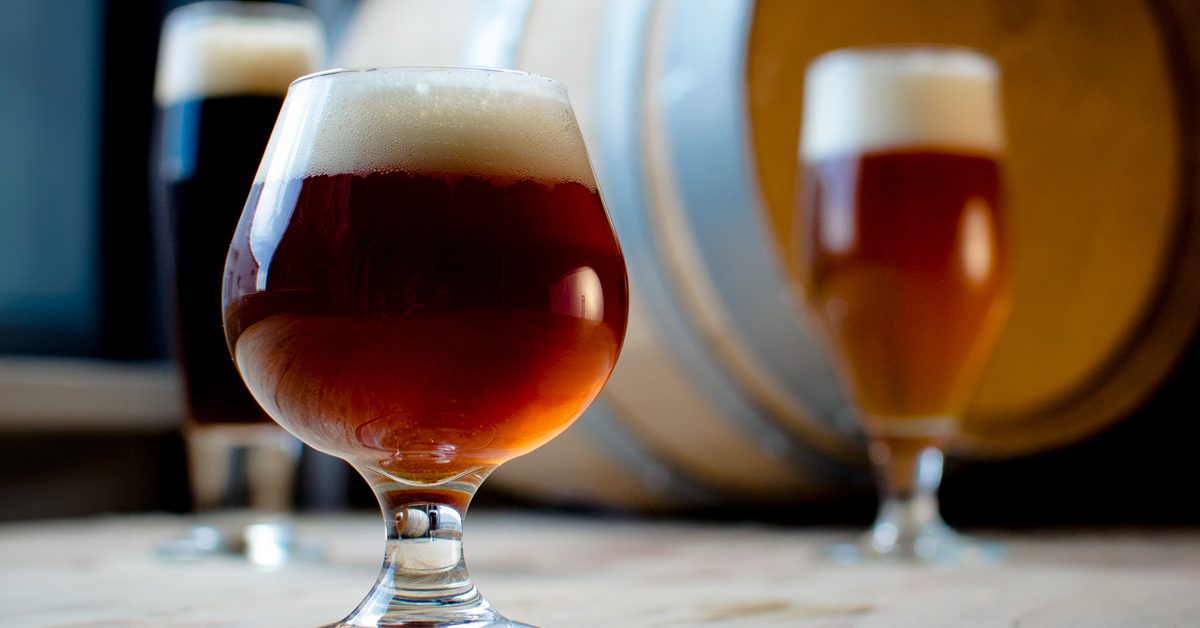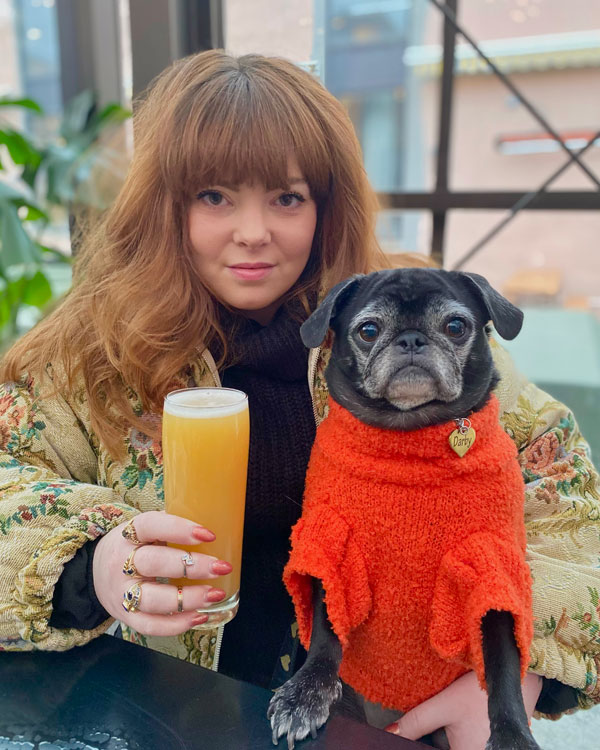Low- and no-alcohol beer has dominated beer industry headlines for several years. The average craft beer fan is getting older and doesn’t want to derail their day with a drink; Gen Z entered legal-drinking status with a focus on wellness; and brewer appreciation for 3% milds and 4% lagers thrives.
More recently, however, there’s an opposing extreme at work, too. Last August, Kate Bernot reported for The Washington Post: “Craft Beer is Polarizing. Many Drinkers Want High ABV or None at All,” examining consumers’ rising interest in high-ABV beers alongside that sustained penchant for near-zero beers. Once a happy medium, beers with middling ABVs are now the odd man out as imbibers choose low-strength beers for health reasons and for longer drinking occasions, and go maximalist with high-strength beers when they’ll be drinking only one or two beers and want the ultimate flavor complexity and a little bit of buzz. Suddenly, imperial beers are getting their own headlines.
“I think this [imperial beer growth] has a direct tie with the state of the U.S. economy,” muses Julie Rhodes, strategic business consultant and founder of Not Your Hobby Marketing Solutions. “Consumers feel like they are getting more bang for their buck with higher ABV offerings.” The fact that 19.2-ounce cans, most frequently containing high-ABV styles such as imperial IPAs, are helping craft beer grow in convenience stores supports the “bigger booze, better value” connection.
Thrifty spending isn’t the only factor buttressing rising ABVs. “Imperial” refers to both big alcohol and big flavor—it means the same thing as “double” or “triple” when you’re discussing a style like an IPA. But across certain styles that have traditionally included IPAs, stouts, and porters, “imperial” instantly conveys expectations of higher alcohol and richer flavor thanks to more grains and hops in the recipe. Increasingly, breweries are taking advantage of that flavor potential. And that means more drinkers are realizing—or remembering—the appeal of imperial beers, and that even those who initially arrive at stronger beers for that better-bang-for-your-buck are finding delicious, thoughtfully crafted beverages.
Finding a Balance
A good brewer can make a beer as complex as it is easy drinking at any alcohol level, from light lagers to barleywines, but stronger beers can indeed empower big, bold flavors. Their requirement of more residual sugars means brewers can play with different ways to temper that sweetness from fruit acidity to hop bitterness.
“With imperial-style beers, you’re given so much more leeway to find that balance in excess and, using that maximalist approach, lean into the intensities of higher IBUs, ABVs, SRMs, and starting/finishing gravities,” says Fred Cullin, a Brooklyn-based beertender who’s brewed at Evil Twin Brewing and Aurora Brewing Co. “For example, if you were to brew a 5% schwarzbier with a higher-than-usual percentage of specialty dark malts, you’d be lacking the desired residual sugar and warming booze to counterbalance the astringency of those malts. But when you amplify that recipe base to 12% and above, you’re able to maximize the roast, chocolate, and coffee imparted by those malts but still create a balanced product.”
More consumer demand for stronger beers means more opportunity for brewers to flex in this space. But one brewery was especially well-positioned for imperial beer’s reign. Greater Good Imperial Brewing Company opened its doors in 2016 in Worcester, Mass. with a mission to corner the strong-beer market and prove how crowd-pleasing the category could be. They’ve helped blaze the modern imperial beer trail in American craft beer while becoming a local favorite. Now, they have a bigger audience.
“It brings a resurgence of energy for me,” says Chris Zampa, Greater Good’s vice president of operations. “I’ve been in the industry 17 years, and any time you find a product people enjoy like this, it’s hard not to get excited. I get even more excited to see the industry following along.”
Zampa says Greater Good founder Paul Wengender saw the opportunity to explore a niche seven years ago. “Most beer companies [then] only had one or two SKUs that might be an imperial or a double IPA. Paul thought there was an area where you could make big beers, but you could also make them regularly drinkable and consumable.” The brewery’s tagline became “Bigger, Bolder, Smoother.” The team set out to push flavor boundaries while demonstrating just how easy drinking imperial beers could be.
Greater Good’s beers demonstrate restraint, with enough residual sugar for that alcohol and big flavor, but with sweetness kept in check with a thoughtfully orchestrated bouquet of complementary flavors and aromas. Consumers already in search of imperial styles sought Greater Good out, while others who happened into the taproom became converts. “I feel like every day I have a conversation with a patron, ‘Just try this,’” Zampa says. “I think people see 12% and think hot, boozy, not approachable. But it is. It’s just getting them to cross that line…and people realize, ‘Oh, wow, this is really good, it doesn’t taste like a shot of whiskey.’”
In the face of this mounting imperial-beer demand, Greater Good is not only poised to welcome this burgeoning crowd, but might very well at least be partially responsible for the swell. They’re not just one of the breweries helping consumers see how smooth and enjoyable an imperial beer can be; they’ve even proven than an entire business focusing exclusively on beers of 8% ABV and higher could thrive. And now, again in the company of fellow well-regarded breweries, Greater Good is pushing the imperial category forward with innovation. They are “imperializing” styles not formerly associated with imperial ABVs, and that diversification could help focus consumers’ fickle attention.
Bucking Tradition
Throughout most of Greater Good’s life so far, the brewery’s beers remained more or less on that expected imperial-strength track, mainly IPAs and stouts. When Colleen Quinn joined the brewery in 2022 as CEO, Zampa says she brought a vision of expanding the portfolio. The brewery formed an innovation committee and got to work thinking outside the hazy-IPA-and-stout box. Their first creation was a Cold IPA, or, depending on who you ask, an India pale lager. “That beer showed us we can explore all the styles we call ‘non-traditional imperial styles’ like lagers, Pilsners, and blonde ales, and do it with the quality we stand behind,” Zampa says. Next came Bombshell, an imperial blonde ale, and Los Imperiales, an imperial Mexican-style lager. Now, every style is on the table, from fruited sours and hoppy amber ales—now pouring in the taproom—to possible Czech-style Pilsners.
In Illinois, Mikerphone Brewing has also seen the appeal of imperializing a typically low-booze Czech style with Flip the Switch, a Czech-style dark lager weighing in at 8%. Upstate New York’s Aurora Brewing Co. put some smoke on its dark lager with Dark Ascent. At 7%, it’s just under what one might consider “imperial,” but significantly stronger than your typical schwarzbier (4.4% to 5.4%). Aurora has also given this treatment to the normally 4.2% to 4.8% gose with Bee Sting. And in New Orleans, Faubourg Brewing Co. captures the spirit of its city with Beignet Au Lait, an imperial blonde ale also clocking in at 7%.
Santa Rosa, Calif.’s HenHouse Brewing Co. knows a thing or two about imperials as well—just take a scroll through its High ABV collection. Like Greater Good, HenHouse skillfully volleys back and forth between playing the hits such as pastry stouts and double IPAs, and introducing consumers to new styles to love, including barrel-aged oyster bière de garde and barrel-aged sour saison. They also honor traditional favorites doppelbock, American barleywine, barrel-aged old ale, and Belgian strong ale.
HenHouse cofounder and CEO Collin McDonnell explains that their imperial beers are motivated by flavor, not simply by that booze factor. “We’re not just making strong beers to make strong beers,” he says. He cites HenHouse’s 9.7% barrel-aged doppelbock, The Greatest Generator. “You can have those caramelly, toasty malt characteristics of a doppelbock, which is strong enough on its own, but if you put a little of that barrel aging on top you get a little toast from the bourbon barrel as well as a little vanilla, caramel, bourbon—which all complement each other nicely.”
Innovation and Education
Because imperial beers are born from flavor—not booze—goals, McDonnell says HenHouse’s overarching emphasis on consumer education is as relevant as ever. He notes the economic element of imperial beer’s current rise, having experienced that people are more likely to buy a 10% imperial stout than an 8% iteration, that double-digit factor kicking the investment over the value goalpost. But McDonnell and the HenHouse team want consumers to understand what’s actually going into that beer, which helps establish how special it is—there’s great value in that purchase, indeed, but not just because of the alcohol content.
McDonnell’s point leads to two further factors that could—in addition to bang-for-your-buck purchases and brewery innovation in imperialized styles—help cement imperial beers as a go-to right alongside those 3% or 0.3% options. One factor is that imperial beers and their educational component are primed for enhanced taproom experiences. “These are the styles that keep people interested in coming into taprooms and trying new things,” McDonnell says. “A barrel-aged doppelbock is not going to do well in mass market channels, but for a majority of small breweries doing their business through tasting rooms, that keeps people close to the brewery.” Innovation within imperial beers alongside consumer education is especially relevant as the craft beer industry’s growth slows and the smaller taproom-based business model becomes the more realistic option for most.
Plus, imperial beers, with their higher alcohol and usually intensive processes from aging to using more unconventional ingredients, will always appeal to consumers seeking a special-occasion beer. They’re often special-occasion beers for the breweries themselves, who choose imperial styles to celebrate their anniversaries. Imperial beers exude a quality that says, “Gift me,” or “Cellar me and enjoy me for a milestone.”
On the other hand, Zampa says Greater Good is also helping people see that you don’t have to save these beers. Having a category of beers to turn to for special occasions can help keep consumers sweet on imperial beers in perpetuity, but the newer revelation fueling imperials’ demand now is the fact that they can be consumed on any old Wednesday, that they can make the occasion special instead of waiting for one.
CraftBeer.com is fully dedicated to small and independent U.S. breweries. We are published by the Brewers Association, the not-for-profit trade group dedicated to promoting and protecting America’s small and independent craft brewers. Stories and opinions shared on CraftBeer.com do not imply endorsement by or positions taken by the Brewers Association or its members.


Share Post